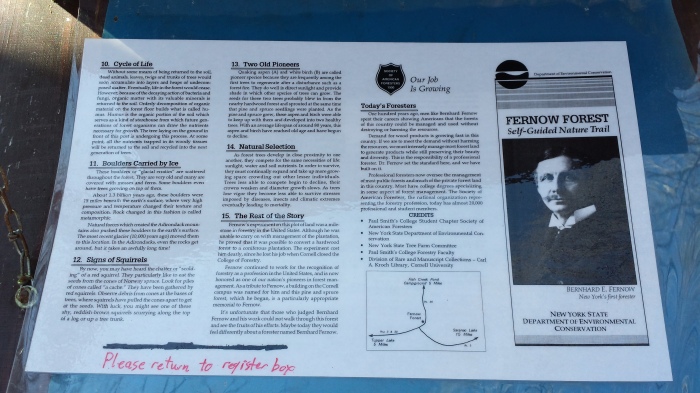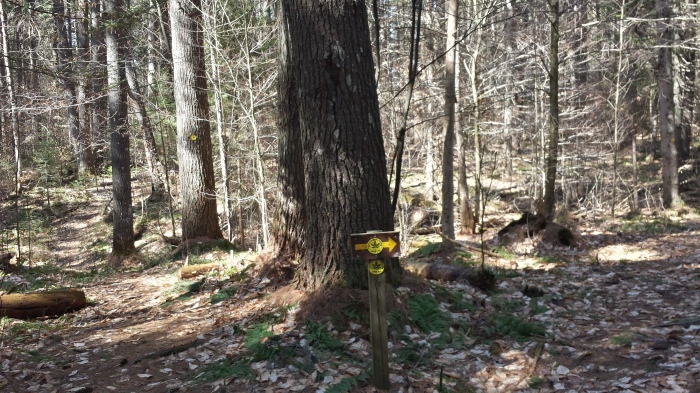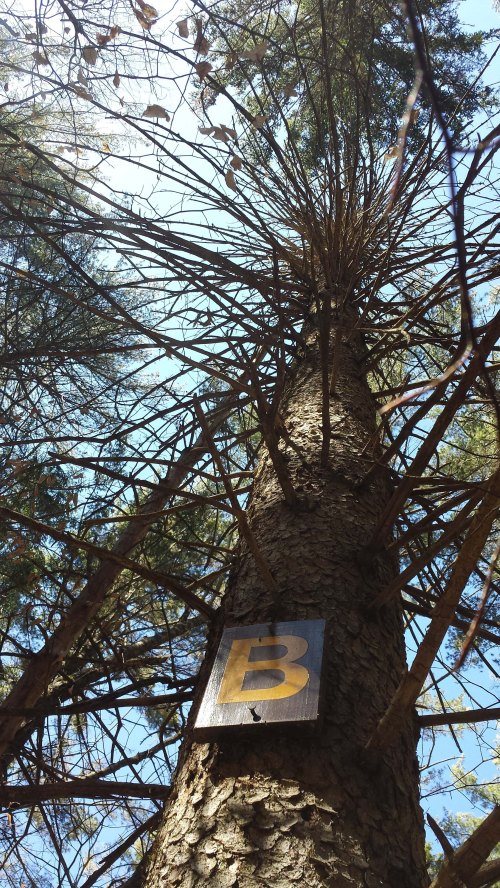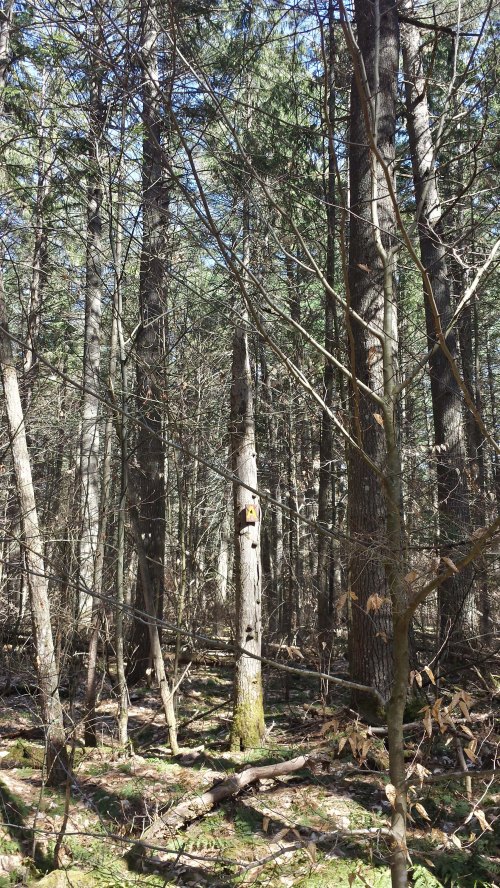A Virtual Tour of New York’s Fernow Forest
 If you find yourself in New York’s Adirondack Park, be sure to add a walk through Fernow Forest to the Forest History Bucket List of things to do while there. It’s a nice place to spend an hour or so stretching your legs and learning about Bernhard Fernow, an important yet underappreciated figure in North American forest history, while looking at a sample of his work in New York.
If you find yourself in New York’s Adirondack Park, be sure to add a walk through Fernow Forest to the Forest History Bucket List of things to do while there. It’s a nice place to spend an hour or so stretching your legs and learning about Bernhard Fernow, an important yet underappreciated figure in North American forest history, while looking at a sample of his work in New York.
Make no mistake: visiting either forest in the United States named for Bernhard Fernow is worthwhile. In West Virginia is the Fernow Experimental Forest on the Monongahela National Forest, operated by the U.S. Forest Service. This 4,300-acre forest offers mountain biking trails and other recreational activities. I’ve not been there yet, but it’s on my bucket list. The one in the Adirondacks is under the control of the state’s department of natural resources.
It’s fitting that Fernow has two forests named for him. As chief of the U.S. Division, predecessor to the U.S. Forest Service, of Forestry he placed the small bureau firmly on scientific footing, writing scores of reports and conducting and coordinating research. Such efforts during his twelve years with the division (1886–1898) make him one of the founding fathers of American forest research, something he rarely receives recognition for. He is better known as the father of professional forestry education in North America. A long-time advocate for forestry education in the America, in 1898, he left the Division of Forestry to establish the New York State College of Forestry at Cornell University. It was the first professional forestry school in the United States (meaning, the first school to offer a college degree). After the school shut down in 1903 (see below), he taught at Yale’s forestry school and elsewhere for a few years. In 1907, he founded the forestry program at Pennsylvania State College’s main campus, teaching there in the spring of 1907 before heading to the University of Toronto and establishing Canada’s first forestry school, where he stayed until his retirement in 1920. The Fernow Forest in West Virginia is a nod to his research leadership; the one in the Adirondacks is one to his work in forestry education.
Fernow located Cornell’s experimental forest on 30,000 acres in the heart of the Adirondack State Park, a decision that would contribute to the demise of the school just five years after it opened. He clearcut the hardwood forest and ordered the planting of the commercially valuable species of white pine and Norway spruce as part of his effort to demonstrate that good forest management could pay. The school sold the lumber to the Brooklyn Cooperage Company, which had set up a mill on the site. Unfortunately, the operation was near several wealthy landowners who didn’t care for the noise and smoke coming from the school’s woods and petitioned the governor to shut down the school. He complied by eliminating funding for the school in 1903, effectively killing it.
But walking the Fernow Forest Trail in the Adirondacks can help a visitor understand what he was trying to accomplish. It was no small goal he had in mind, trying to teach his students the fundamentals of forestry and demonstrate to an indifferent country that forest management could turn a profit and produce a steady supply of lumber.
Located on a 68-acre tract that was once part of the school forest, the trail is a under a mile long, a well-groomed dirt path that’s fairly level and easily navigated. Much like Fernow the historic figure, it’s easy to overlook the trail along the road. Marked by an underwhelming sign, with parking in a pullout on the shoulder of NY 3, you have to pay attention when looking for it or you’ll go right by it. Unlike the Carl Schenck Redwood Grove in California, which is a good distance from the road, you never quite get away from the sound of cars in Fernow Forest.
Also unlike Schenck Grove, which celebrates the man and his ebullient spirit, Fernow’s trail is like him—all business, with an emphasis on education. This trail not only informs you about Fernow and the school, but also how and why he was managing the land, what has occurred on the land since the school’s demise, and a bit about the geological history of the land. The forest is no longer actively managed except for trail maintenance done by students from nearby Paul Smith’s College (also worth visiting). With that background, let’s get going.
When you start the walk, be sure to sign in at the trailhead so the state knows how many people use it. Borrow a laminated trail map, which interprets the different stops along the trail.

Be sure to peruse the sign-in sheets to see where others visited from. Someone from France had visited not long before I did.
At stop #1, you learn that you’ve been walking through a northern hardwood forest and are about to transition to the softwoods of the Fernow Forest (which begins at stop #2). It consists largely of Norway spruce and eastern white pines (indicated with signs at stops 4 and 5, respectively) planted at Fernow’s direction in rows. Most rows are still visible, running perpendicular to the trail.

Stop #3 commemorates the man himself with a tablet attached to a massive boulder.
The tablet reads: “This Forest Plantation and Trail Dedicated to BERNHARD E. FERNOW 1851 – 1923.” It includes this quote from Fernow: “I have been unusually lucky to see the results of my work. I have been a plowman who hardly expected to see the crop greening, yet fate has been good to me in letting me catch at least a glimpse of the ripening harvest.”
This being a nature trail on state land, you’re going to learn a little bit about everything that goes on in a forest, something I’m sure Fernow would heartily approve of. So at stop #6 you’ll find a tree suffering from White Pine Blister Rust and at #7 a white pine (labeled with an A) and a Norway spruce (B) under attack from the White Pine Weevil, an insect that doesn’t limit itself to one tree species.
When you get to stop #8, you’re about half-way through the trail. This is the back of the property, which abuts private property. Stop #9 asks, “Where Did These Two Red Pines Come From?” Apparently a couple of them where mixed in with the white pine seedlings planted here and the signs point them out.
I’ll wait while you flip the pamphlet over. Click on the image to read it.

Stop #10, “Cycle of Life,” gives a lesson in forest ecology, telling how decaying matter enriches the soil and provides nutrients for new trees to grow. At stop #11, “Boulders Carried by Ice,” we learn that the boulders in the forest, like the one holding the tablet, started out 15 miles beneath the earth’s surface and were forced upward as the Adirondack Mountains formed, and then were moved about by the retreat of the last glacier 10,000 years ago. Stops 12 and 13 talk about some of the occupants of the forest: the red squirrel (12), and how to spot signs of its presence, and at 13 “Two Old Pioneers,” quaking aspen and white birch trees.
“Quaking aspen (top) and white birch (below) are called pioneer species because they are frequently among the first trees to regenerate after a disturbance such as a forest fire.”

If you aren’t already depressed from learning about blister rust, cankers, forest fires, nature decay, and the failure of Fernow’s school, we are reminded at stop #14 that “Natural Selection” eventually leads to the death of trees as they compete for sunlight and nutrition before succumbing to the pressures of disease, pests, or weather. (If nature fails to do its job, the band Rush reminds us that “trees are all kept equal by hatchet, axe, and saw.” I’m sure Fernow would approve of that as well.)
But! We do have a somewhat happy ending to “The Rest of the Story” at stop #15. We’re told that Fernow’s experiment was a milestone in forestry in the United States. “Although he was unable to carry on with management of the plantation, he proved that it was possible to convert a hardwood forest to a coniferous plantation.” But the “experiment cost him dearly, since he lost his job when Cornell closed the College of Forestry.” Cornell later named its forestry building after him (they established a department of forestry after the New York State College of Forestry reopened at Syracuse University in 1911). Then the pamphlet closes the tour on a note of pity by saying, “It’s unfortunate that those who judged Bernhard Fernow and his work could not walk through this forest and see the fruits of his efforts. Maybe today they would feel differently about a forester named Bernhard Fernow.”

This way to the exit. Be sure to return the pamphlet and close the box up. And drive safely!
Filed under: Historian’s Desk Tagged: Adirondack State Park, Adirondacks, Bernhard Fernow, Bucket List, Canada, conservation, Cornell University, New York, Penn State, vacation ![]()






